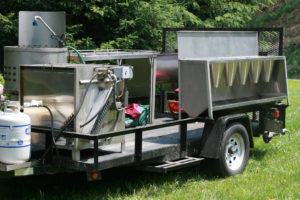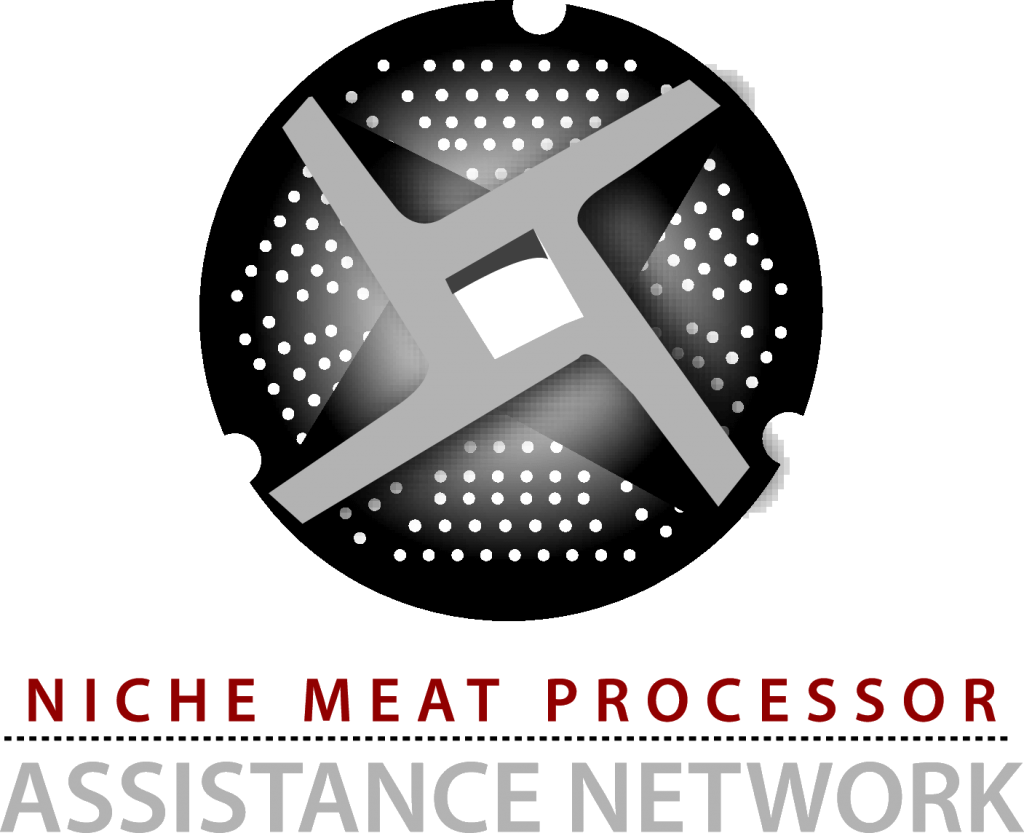Poultry are unique in the meat processing world. There are different regulations, poultry specific processors, allowances for on-farm processing, mobile poultry processing units, and specific food safety research that pertains to poultry. Now you can find all the NMPAN resources on these subjects on one page. For a list of independent USDA-inspected poultry processing plants, you can now click on this link to see a map and table.
 MPPU built by Mike Badger, Millside Farm, PA
MPPU built by Mike Badger, Millside Farm, PA
This page includes the following sections:
- Poultry Processing Regulations
- USDA Inspected Poultry Plants (also see this link)
- On-Farm Poultry Processing Best Practices
- Mobile Poultry Processing Units
- Food Safety Research
- Producer Resources
Poultry Processing Regulations
USDA Inspection
The federal Poultry Products Inspection Act (PPIA), administered by USDA’s Food Safety and Inspection Service (FSIS) is the primary law governing poultry processing.
The PPIA requires that poultry, to be sold as human food, must be slaughtered and processed in a facility with continuous bird-by-bird inspection. This can be federal inspection or state inspection in the twenty-five states with their own poultry inspection programs.
HACCP for Poultry
Here is a Generic HACCP Model Plan for Poultry Slaughter, provided by the USDA FSIS.
USDA Exemption (P.L. 90-492)
The PPIA contains some exemptions (known as Public Law 90-492) for small producers/processors, allowing slaughter without continuous, bird-by-bird inspection. But exempt processors still have to follow sanitation, recordkeeping, and other rules. Exempt processors use simple on-farm open-air setups, on-farm buildings, mobile slaughter units, or sometimes brick and mortar plants that process for multiple producers. The extent of the infrastructure is often related to how the particular state interprets the P.L. 90-492 rules. States are allowed to adopt more stringent regulations or not accept the federal exemptions at all.
Want to know what your state requires? Download the latest 2018 NMPAN Guide to State Poultry Processing Regulations.
The report currently includes all 50 states, but with 3 of those states in draft form. We will add information for the remaining states as possible. This guide is NOT a legal document and should NOT be considered legal advice. Please double-check with state agencies and/or FSIS before you start any processing operation.
This table below, adapted from the FSIS guidebook on the exemptions, explains where you can sell poultry processed under the different exemptions.
The exemptions, regulated by Chapter 9, Code of Federal Regulations, Section 381.10, are explained in this FSIS guide: “Guidance for Determining Whether a Poultry Slaughter or Processing Operation is Exempt from Inspection Requirements of the Poultry Products Inspection Act”. NOTE: There are known errors in this guide and FSIS intends to update it.
USDA Inspected Poultry Plants
ATTRA tries to keep this list of small poultry processing facilities up-to-date. Some are USDA inspected, some state inspected, some are custom plants. Most are plants that will process for independent producers. For the latest USDA inspected listing, use the FSIS search engine here. Note: The USDA FSIS listing will not tell you if a plant does processing for independent producers. You will have to call the plant to find out.
NMPAN has also recently compiled this list below of USDA inspected poultry processors that are willing to do fee-for-service processing for independent farmers. Some only do chicken, others are willing to do other poultry species (turkey, duck, goose, squab, etc.). Call to find out. NMPAN does not endorse any specific processors- this list is provided as a reference only. Updated 12.14.2017
Design & Costs to Build USDA Inspected Plant
Report on the Feasibility of a Small-Scale Slaughter Facility for Independent Meat Producers in North Carolina, prepared for North Carolina Dept. of Agriculture & Consumer Services by Smithson Mills in 2007. This report focused on poultry and rabbits and led, in part, to the development of the Foothills Pilot Plant in Marion, NC that recently closed in late 2017.
Case Studies & Business Plans
Here is a case study of White Oak Pastures in Bluffton, GA who operate both a USDA inspected red meat and poultry plant on their farm.
On-Farm Poultry Processing Best Practices
Techniques & Equipment
Written by Dr. Lauren Gwin and Rebecca Thistlethwaite, Best Practices Guide for Open-Air Poultry Slaughter, OSU Extension publication #EM9273. Updated January 2020. Available in Spanish as well here, La Guia de Buenas Practicas para el Sacrificio al Aire Libre de Aves de Corral.
On Farm Poultry Slaughter Guidelines, a joint publication of Cornell University and NE Beginning Farmers Project.
Safer Management Practices for Small Poultry Processors, a publication of SARE.
Cost Analysis/Economic Feasibility
Painter et al. Pacific Northwest Extension Publication #665. From Food Safety to Economics: Processing Your Chickens for Market.
Managing Risks in On-Farm Poultry Processing, with discussions of regulations, costs, and food safety considerations. A publication of University of Tennessee Extension.
Mobile Poultry Processing Units (USDA Inspected & Exempt)
Case Studies
Kentucky Mobile Poultry Unit– The University of Kentucky makes their mobile poultry processing unit available to Kentucky producers, who are trained in food safety before using it. This unit was featured in a 2012 NMPAN webinar on mobile poultry processing units.
Hudson Valley Mobile Poultry Unit– The builder/operator of this mobile poultry processing unit in New York designed it to be used by other, licensed producers to process their own birds for sale. In 2011, he stopped processing for other producers: at the price producers were willing to pay, processing revenue did not cover processing costs (including transactions costs).
Vermont Mobile Poultry Unit– This mobile poultry processing unit was built by the state of Vermont as a prototype and was leased by a private operator. It transitioned to new owner/operators in 2012. This unit was featured in a 2012 NMPAN webinar on mobile poultry processing units.
Cost Analysis/Economic Feasibility
Simone Angiolini et al. in Renewable Agriculture and Food Systems, July 2015. Economic feasibility of mobile processing units for small-scale pasture poultry farmers
Design & Equipment
A guide to planning and constructing a Mobile Poultry Processing Unit (MPPU) or stationary poultry processing facility on your farm, created by New Entry Sustainable Farming Project in 2012, goes into components, floorplans, and costs.
One idea for on-farm processing that is not mobile, but doesn’t require a foundation per se, is the Plant In a Box idea. Read more about this concept from former NMPAN Program Manager Kathryn Quanbeck here.
Here is a document on design considerations for the construction and operation of a brick and mortar meat and poultry facility. It goes into the differences between a red meat versus a poultry plant.
Food Safety Research
Pathogen Research
Trimble et al. in Food Control, April 2013. Salmonella and Campylobacter prevalence and concentration on pasture-raised broilers processed on-farm, in a Mobile Processing Unit, and at small USDA-inspected facilities
Bucher et al. in Preventative Veterinary Medicine, January 2012. A systematic review-meta-analysis of chilling interventions and a meta-regression of various processing interventions for Salmonella contamination of chicken.
Controlling Salmonella in Poultry Plants, a USDA FSIS slideshow.
On-Farm Management Practices
Walid Alali et al. in American Pastured Poultry Producers Association Grit Issue #72, 2013. From Food Safety to Economics: Processing Your Chickens for Market
Alternative Anti-Microbials
Cleaning and Disinfecting in Organic Poultry Production, a list of approved materials by Dr. Jacquie Jacob.
Producer Resources
The American Pastured Poultry Producers Association (APPPA) is a membership based organization that provides the following resources: maintains a large, active listserv, prints a bi-monthly newsletter, offers webinars, conference calls, and workshops, funds some on-farm research, and more. Additional information can be found here.
The National Center for Appropriate Technology (NCAT) also had a considerable amount of publications available to pastured poultry producers on topics such as genetics, feeding, health, processing, marketing, and more. See their resources here.


